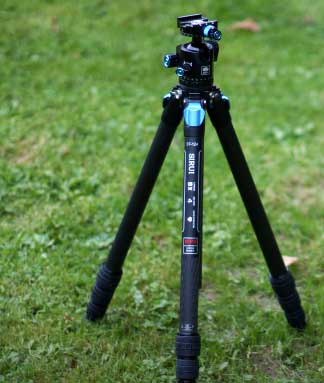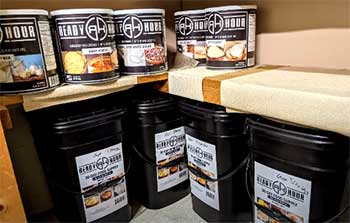Tripods are an essential tool for photographers and videographers looking to capture sharp, blur-free images and smooth video footage. But with so many options on the market, choosing the right tripod can be tricky.
Two popular models from Sirui are the ST-124 and ST-125 tripods, but what’s the difference between them and which one is better for your needs?
In this in-depth comparison, we’ll take a close look at the specs, features, pros and cons of the Sirui ST-124 and ST-125 tripods to help you decide which is the best tripod for you.
A Brief Comparison Table
| Feature | Sirui ST-124 | Sirui ST-125 |
| Maximum Height | 55.1 in | 56.7 in |
| Minimum Height | 14.9 in | 15.4 in |
| Folded Length | 18.9 in | 19.5 in |
| Weight | 3.3 lbs | 3.53 lbs |
| Load Capacity | 13.2 lbs | 13.2 lbs |
| Leg Tubes | Aluminum | Carbon fiber |
| Leg Locks | Twist locks | Flip locks |
| Head Type | E-10 pan/tilt head | K-10X ballhead |
| Head Capacity | 8.8 lbs | 26.5 lbs |
| Center Column | Standard straight | Pivoting |
| Price | $260 – $300 | $380 – $450 |
In-depth Differences Between Sirui ST-124 And ST-125 Tripods
- Key Specs Comparison
First, let’s look at some of the key specs and measurements of these two Sirui tripods:
- Maximum height: The ST-124 extends to 55.1 inches while the ST-125 reaches up to 56.7 inches at full height.
- Minimum height: The ST-124 goes down to 14.9 inches versus 15.4 inches for the ST-125.
- Folded length: The ST-124 measures 18.9 inches when collapsed and folded up compared to 19.5 inches for the ST-125.
- Weight: The ST-124 weighs 3.3 lbs while the ST-125 is slightly heavier at 3.53 lbs.
- Load capacity: Both tripods support up to 13.2 lbs of gear weight.
As you can see, the specs and measurements are very similar overall between these two tripod models. The ST-125 is marginally taller and heavier than the ST-124, but only by minor increments.
- Build Quality and Construction

Both Sirui tripods have excellent build quality with aircraft grade magnesium alloy construction.
This makes them lightweight yet very sturdy and rigid.
The leg sections, locks, and joints are all tightly assembled with no wiggle or loose parts.
The tripod feet also have thick rubber feet that grip surfaces well and have retractable metal spikes for outdoor use.
One advantage of the ST-125 is that it uses carbon fiber leg tubes instead of aluminum like on the ST-124.
This further reduces the weight while maintaining strength. The carbon legs are nicer, but the aluminum legs on the ST-124 are still very solid and durable.
Both tripods have foam padding on the leg locks and carry handle for comfort during transport. Overall, build quality is excellent on both models but the ST-125 gains points for the carbon fiber legs.
- Leg Angle Adjustments
The ability to adjust the angle and position of the tripod legs is key for versatility to shoot from different heights and on uneven terrain.
Both the Sirui ST-124 and ST-125 tripods offer a similar range of leg angles. You can independently adjust each leg section between about 25-80 degree angles.
This allows you to splay the legs out wide for low shooting positions or to fold them up into a narrower upright triangle shape.
The ST-125 does have an additional lower intermediate leg angle around 16 degrees. This can help get the tripod a little lower to the ground compared to the ST-124’s minimum leg angle of around 25 degrees.
So if you need to get as low as possible, the ST-125 has a slight advantage in leg flexibility. But both provide excellent adjustability from the ground up.
- Tripod Heads
The tripod head is a critical factor that differentiates the Sirui ST-124 and ST-125 models.
The ST-124 comes with Sirui’s E-10 head, which is an entry-level basic head with separate knobs for panning and tilting. It can support up to 8.8 lbs of gear and allows for 360° panning and -20° to +90° tilt range.
The ST-125 includes the more advanced K-10X ballhead. This has an integrated ball bearing and one locking knob to allow smooth, precise camera movements in all directions. It supports up to 26.5 lbs equipment weight.
Both heads have an Arca-Swiss style quick release plate. But the K-10X on the ST-125 is a much nicer head overall with greater load capacity and smoother adjustments. It’s especially better for smooth video panning and tilting in all directions.
So if your budget allows, the upgraded ballhead makes the ST-125 a better complete tripod kit. But the E-10 head on the ST-124 still performs quite well for general still photography needs.
Also Read: Comparison of Canon And Fujinon Binoculars.
- Center Columns
The center column on a tripod allows you to raise the height for shooting above eye level. Both Sirui models have center columns, but with some differences.
The ST-124 has a typical straight center column that telescopes up for added height. It can be locked in place at varying levels.
Whereas the ST-125 has a pivoting center column. This allows you to tilt the column horizontally to 90 degrees for unique high or low angled shots. The pivoting column is more versatile and easier to adjust off-level.
The pivoting function is convenient for macro or product photography where you need to get the camera low and angled. Both tripods allow you to invert the center column down below the tripod legs for ultra-low shooting positions also.
So the pivoting column design gives the ST-125 a nice advantage in flexibility and speed of height adjustments. But the standard column on the ST-124 still allows for added height when needed.
- Twist Locks Vs. Flip Locks

The leg sections on these Sirui tripods are secured in place with different locking mechanisms.
The ST-124 uses twist lock knobs while the ST-125 has flip lock levers.
Twist locks require rotating knobs around the leg tubes to loosen and tighten them in position.
Flip locks simply flip up or down to lock and unlock the leg segments.
Flip locks allow you to extend the tripod legs a little quicker without having to twist any knobs.
But twist locks offer a more secure grip and won’t loosen over time like flip locks sometimes can.
This one comes down to personal preference. Twist locks are typically a bit stronger and less prone to accidental release. But flip locks can be faster if you need to set up or take down the tripod frequently. The locks on both models work well and reliably.
- Carrying Cases
Both Sirui tripod kits come with a nice custom padded case that makes it easy to carry and protect the tripod during travel and storage.
The ST-124 includes a straight tube-style case while the ST-125 has a slightly larger zippered bag case. Both have a shoulder strap and handle for easy carrying.
The cases are well made and allow you to pack up the tripods conveniently. Overall there’s not a significant difference between the two types of cases.
- Price Comparison
As you would expect based on the additional features and upgrades, the Sirui ST-125 generally sells for around $120 to $150 more than the ST-124.
The ST-124 retails around $260 to $300 on average, while the ST-125 costs $380 to $450. The price gap depends on where you purchase from.
So if your budget is tight, the ST-124 can save you some money while still getting you a very capable tripod. The ST-125 is a more complete kit with nicer upgrades like the ballhead and carbon legs – but for a higher price tag.
Also Read: Comparison of Ollin And Magview Digiscoping Adapters.
Which One Should You Get?
Choosing between these two great Sirui tripods comes down to your shooting needs and budget considerations:
- For photographers on a tighter budget, the ST-124 provides excellent quality and features at a more affordable price point. It’s a great entry-level tripod.
- The ST-125 is the nicer model overall with the upgraded pivoting center column, smoother ballhead, and lighter carbon legs – albeit at a higher price. It’s ideal if budget is less of a constraint.
- Both support plenty of gear weight, but the ST-125 can handle heavier long telephoto lenses better with its higher 26.5 lb capacity ballhead.
- For frequent low angle shooting, the ST-125’s pivoting center column and lower minimum leg angle allow you to position the camera with more flexibility.
- Videographers may favor the ST-125 for its smoother panning and tilting with the ballhead plus faster flip lock leg adjustments.
- Casual photographers who don’t need professional features will be very happy with the performance and value of the more affordable ST-124 model.
- The ST-124 with aluminum legs is a bit heavier but still very portable for travel and location shooting. The ST-125 sheds a few extra ounces with the carbon fiber construction.
Final Thoughts
In conclusion, the choice ultimately depends on your specific photography needs and budget you wish to invest in a tripod. If you desire maximum versatility, the ST-125 is Sirui’s highest quality option.
But the ST-124 still delivers outstanding stability and features for photographers who don’t require carbon fiber legs or a top-end ballhead.
Both are well-made tripods that will serve you reliably and last for years. Hopefully this detailed comparison gives you a better feel for the differences between the Sirui ST-124 and ST-125 tripods to decide which is the right fit for your camera gear and shooting scenarios.

